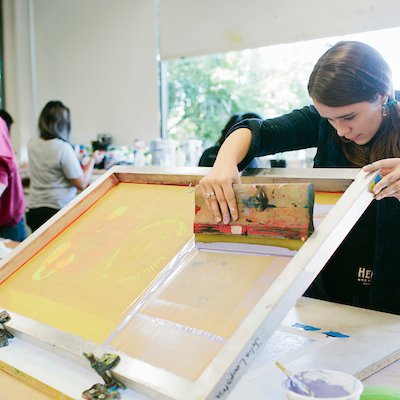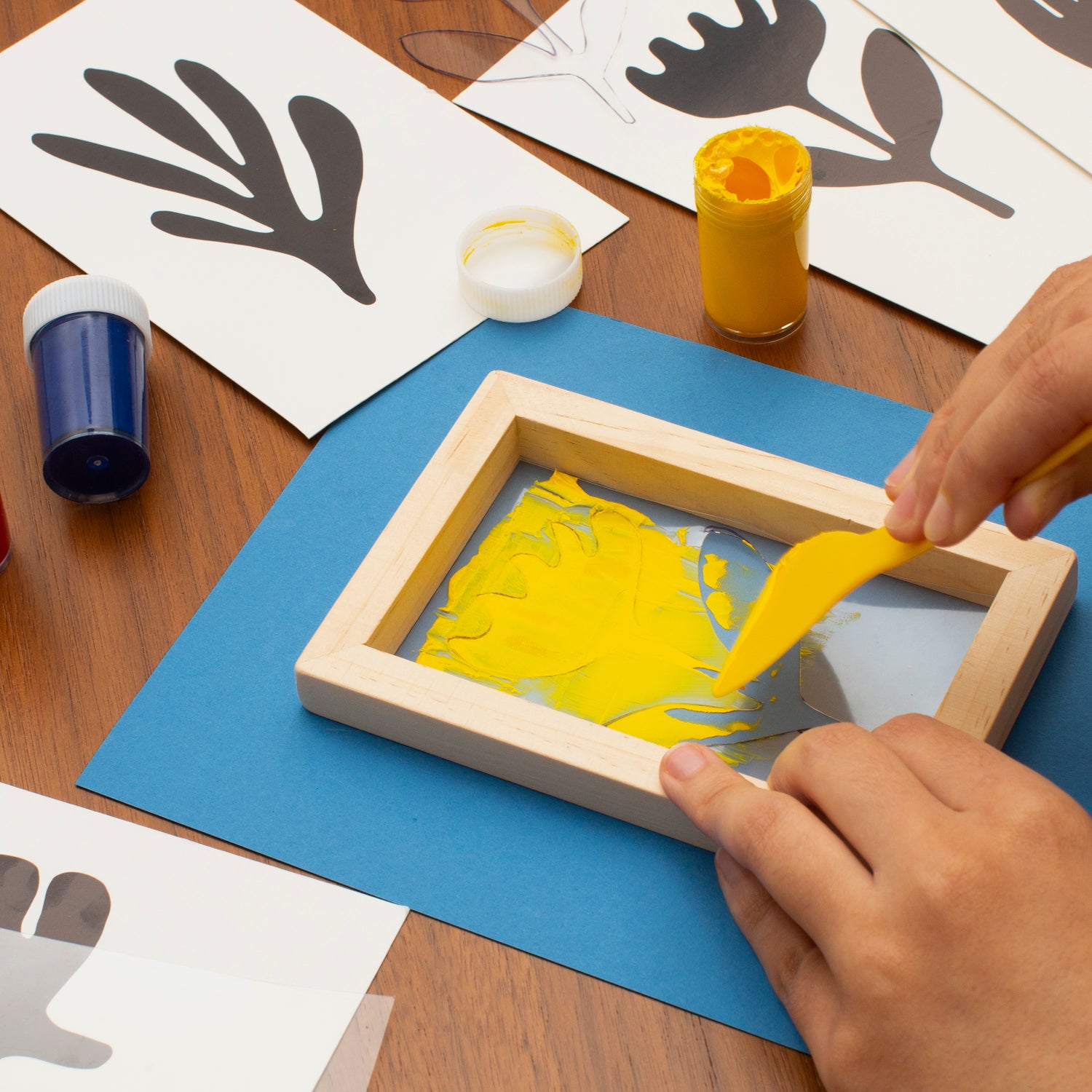ChatGPT said: How 10:9 Design Texas is redefining the screen printing industry
Wiki Article
Discover the Numerous Sorts Of Screen Printing Techniques for Your Next Project
Screen printing provides a diverse variety of methods that can enhance any imaginative task. From traditional methods like serigraphy to modern-day innovations such as direct-to-garment printing, each approach has its one-of-a-kind advantages. Specialized alternatives, consisting of environment-friendly and metallic inks, introduce even more opportunities. Comprehending these techniques can greatly impact the final end result. However, the difficulty depends on selecting one of the most suitable technique for specific demands and wanted results. What aspects should one consider?
The Basics of Screen Printing
Although screen printing might seem complex, it is essentially a straightforward procedure that includes moving ink through a mesh screen onto different surface areas. The strategy begins with the creation of a stencil, which defines the style to be published. This pattern is attached to a mesh screen, typically made from polyester or nylon. Once the stencil remains in location, ink is related to the screen and pressed via the mesh making use of a squeegee, resulting in the preferred pattern being printed on the underlying material.Screen printing can be performed on a vast array of substratums, consisting of textile, paper, and plastic, making it a versatile selection for different projects. The procedure enables elaborate layouts and vivid shades, making it preferred in sectors such as advertising and marketing, art, and style. Understanding these basics equips people with the fundamental expertise needed to check out advanced strategies in screen printing.
Standard Screen Printing Techniques
Standard screen printing techniques have been used for centuries, maintaining the craftsmanship and artistry of this approach. This approach uses a mesh screen to move ink onto a substratum, such as material or paper, permitting lasting and lively layouts. The procedure begins with creating a pattern, which blocks particular locations of the screen to manage where the ink will certainly be applied.One prominent technique is serigraphy, usually made use of for restricted versions and artistic prints. An additional is using water-based inks, which are environmentally friendly and supply a soft feel on textiles - 10:9 Design Company. Additionally, typical methods can include hands-on printing, where craftsmens apply ink with a squeegee, making sure accuracy and attention to detail
These methods continue to be valued in the industry for their tactile top quality and the unique textures they generate, appealing to both consumers and developers who appreciate the heritage of screen printing.
Digital Screen Printing Innovations
As the demand for faster production and modification in the printing market has surged, digital screen printing developments have emerged as a game-changer. This innovation blends standard screen printing approaches with electronic procedures, permitting for quick prototyping and complex layouts that were formerly tough to attain. One considerable innovation is the intro of direct-to-garment (DTG) printing, which facilitates top quality, full-color prints on various textiles without the need for screens. Additionally, advancements in ink formulations have actually led to environment-friendly choices that preserve lively shades while reducing ecological influence. Using automated systems better enhances production, lowering labor costs and enhancing precision. These advancements not only provide to tiny set orders and tailored styles but additionally enable for quicker turnaround times, making them excellent for businesses concentrated on meeting customer needs in a hectic market. Digital screen printing, subsequently, stands for an important advancement in the domain name of printing strategies.Specialty Screen Printing Techniques
Exploring specialized screen printing methods discloses a varied array of strategies that push the limits of creativity and performance in the printing market. Amongst these, glow-in-the-dark inks offer a distinct aesthetic impact, making layouts come alive in low-light problems. Metallic inks, recognized for their shimmering finish, add a touch of deluxe to published materials. An additional innovative technique is discharge printing, which removes dye from the fabric rather than adding ink, resulting in a soft, classic feeling. High-density printing develops an elevated appearance on the surface, improving responsive engagement. Furthermore, water-based inks are obtaining appeal for their dynamic shades and lowered environmental impact. Each of these specialty strategies deals with certain design needs, allowing artists and brands to create standout products that resonate with their audiences. By leveraging these techniques, businesses can elevate their screen printing projects to brand-new elevations, ensuring unforgettable perceptions.Eco-Friendly Screen Printing Options
Green screen printing alternatives are gaining traction as the industry changes towards sustainability. Sustainable ink choices and using biodegradable materials are vital components in minimizing the ecological effect of the printing procedure. By taking on these techniques, screen printers can add to a more sustainable future while keeping top notch outcomes.Sustainable Ink Choices

Biodegradable Products Usage
As the screen printing market progresses, the incorporation of naturally degradable products is ending up being progressively crucial for ecologically mindful methods. Makers and developers are now exploring inks and substratums made from all-natural, renewable energies that disintegrate much more efficiently than traditional equivalents. These eco-friendly choices decrease plastic waste and lessen ecological influence, lining up with the expanding demand for lasting items.
Typical examples include water-based inks and natural cotton textiles, both of which reduce damaging chemicals and promote eco-friendliness. Brand names that embrace these products usually improve their market appeal, bring in consumers who focus on sustainability. As understanding of environmental concerns continues to climb, the change towards biodegradable products in screen printing is most likely to gain energy, cultivating a greener sector standard.
Picking the Right Technique for Your Project
Just how can one determine one of the most appropriate screen printing strategy for a certain task? The decision rests on a number of elements, consisting of the material to be printed on, the intricacy of the layout, and the preferred manufacturing volume - 10:9 Design contact. Direct-to-garment printing is ideal for complex layouts with numerous colors, while standard screen printing succeeds for bigger runs of simpler graphics.
Furthermore, factor to consider of the end-use of the published item is necessary. For exterior applications, techniques that provide resilience and weather condition resistance, such as plastisol ink, might be preferred. On the other hand, environmentally-conscious tasks might take advantage of water-based inks or naturally degradable products.
Eventually, understanding the task's unique demands enables website for an educated option, making sure both visual allure and useful longevity. By evaluating design complexity, product compatibility, and manufacturing scale, one can properly choose the most ideal screen printing technique to meet their project's goals.
Often Asked Concerns
What Is the History of Screen Printing?
Screen printing came from in ancient China around 1000 AD, developing through Japan and Europe. By the 20th century, it became popular in commercial art and style, transforming how designs were produced and distributed worldwide.
Just how Do I Prepare Artwork for Screen Printing?
To prepare art work for screen printing, one must assure high resolution, use an appropriate shade mode, produce separate layers for each and every color, and convert message to outlines, assuring compatibility with the printing procedure and preferred outcome.What Products Are Best for Screen Printing?
The finest products for screen printing consist of high-quality inks, long lasting displays, and ideal substratums like cotton, polyester, or blends. Additionally, utilizing proper solution and mops can boost the printing procedure and outcomes.Can I Screen Print at Home?
Yes, screen printing at home is possible. With the ideal products, arrangement, and techniques, people can create top notch prints. Cautious consideration of office and tools is vital for effective results.What Prevail Errors in Screen Printing?
Usual errors in screen printing include improper direct exposure times, inadequate ink uniformity, misalignment of displays, insufficient cleansing of materials, and overlooking to evaluate prints. These mistakes can jeopardize the quality and precision of the end product.Screen printing might appear complicated, it is essentially a straightforward procedure that involves transferring ink through a mesh screen onto various surface areas. As the need for faster production and personalization in the printing sector has risen, electronic screen printing developments have actually arised as a game-changer. Checking out specialized screen printing approaches discloses a diverse variety of strategies that press the limits of creative thinking and functionality in the printing industry. The finest products for screen printing consist of top quality inks, long lasting displays, and suitable substrates like cotton, polyester, or blends (10:9 Design Company). Common errors in screen printing include incorrect direct exposure times, poor ink uniformity, imbalance of displays, not enough cleansing of products, and overlooking to check prints
Report this wiki page